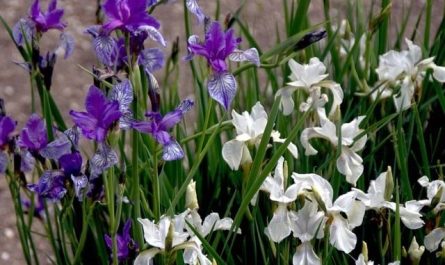Of the more than 100 species of lilies found in nature, just over three dozen are grown as garden plants. But species lilies are a rarity today. In fact, only the narrow-leaved, white and royal lilies remain common plants. Most lilies grown in gardens are hybrids and varietal plants. Understanding their classifications is not at all easy. More than three thousand plant varieties and complex interspecific crossing have changed the classifications beyond recognition and generated a huge number of variations and criteria for assessing lily species and classes.

Historical information
Graceful, fragrant, beautiful lilies are considered by many to be the almost perfect flowering garden plants. Elegant queens, one of the most ancient and prestigious plants, truly deserve their special reputation.
Lilies received their recognition several thousand years ago. Their name is mentioned by ancient Greek and Roman philosophers and poets, and the divine origin of lilies was “recorded” in ancient Greek myths. According to them, lilies grew from drops of milk of Zeus’s wife, the goddess Hera.
As early as the 4th century BC, Hippocrates glorified the lily as a medicinal plant, and Dioscorides cemented the irreplaceable status of white lilies in his works. In ancient Rome, lilies were the most respected flowering plants after roses, an invariable symbol and the main decoration of temples and celebrations in honor of the goddess Flora.
Even then, lilies were perceived as a symbol of purity and innocence, and in many ways these flowers have not lost this meaning in heraldry and floristry today, as well as their ancient Roman status as a symbol of sophistication and luxury. The capital of Ancient Persia, the beautiful Susa, was even named after this plant and was known as the “city of lilies”.
In Ancient Egypt, the lily and its images were perceived as a symbol of freedom, hope and the transience of life. With the spread of Christianity, the status of the lily only strengthened. After all, it was its flowers that became the symbol of the Virgin Mary, and the snow-white lily received its second name – the Madonna lily. This plant already in the Middle Ages became the emblem of the French kings.
Botanical name Lilium, of course, this beautifully blooming legend received much later, during the first entry into official documents snow-white lilies (lilies candidum). The roots of the name “lily” go back either to the ancient Gallic “white-white”, or to the ancient Greek “white”, and some sources even appeal to the ancient Celtic “whiteness”.

Botanical classifications
Botanical classifications are almost not applicable in landscape design (and are not used even in lily breeding centers). Lilies are divided not only by the structure of the flower, but also by a dozen other criteria, combining them into sections, divisions and groups.
International Botanical Classification lilies divides them into sections and is the author of G. Comber. It was developed back in 1949 and is considered official. Lilies according to it are divided into sections:
- Section 1. Martagon, the typical lily of which is martagon.
- Section 2. Pseudolirium with typical Philadelphia lily, which is further divided into three subsections according to the habitat of the species.
- Section 3. Liriotypus with typical snow-white lily.
- Section 4. Archelirion, typical lily – golden lily.
- Section 5. Sinomartagon, typical appearance – lily of David, is divided into 3 subsections.
- Section 6. Leucolirion with a typical appearance longiflorum lily.
- Section 7. Daurolirion with a typical appearance Pennsylvania lily.
Domestic version and even provides for the allocation of 11 sections, the names of which never appear in the catalogues.

Official garden classification of lilies
Garden classifications are much more convenient, because they unite lilies into sections not only by indistinguishable features or origin. All plants in them are similar in winter hardiness, resistance, care requirements, and propagation methods. And it is the section that is usually indicated in catalogs and garden centers for each variety and type of lily.
The official garden classification of lilies is accepted by the Royal Society and is fixed International Lily Registry (International Lily Register) much later. This classification was published in 1982. It is convenient for both inexperienced gardeners and professionals, and was created to make it easier to navigate the range of varieties when selecting plants for your garden.



The International Garden Classification divides lilies into 8 sections:
- Asiatic hybrids (Asiatic Hybrids) is a legendary and very popular range of early-flowering, unpretentious and frost-resistant lilies, the varieties of which were obtained by crossing Asian species of lilies.
- Tubular hybrids (Trumpet Hybrids) – late-flowering varieties of Asiatic lilies that require special conditions and pleasantly surprise with their frost resistance and resistance to diseases.
- American hybrids (American Hybrids, sometimes they are called Orleans hybrids) trace their history back to the leopard and Canadian lilies, and boast exotic flowers of very bright colors. They are very difficult to care for, but frost-resistant varieties.
- Martagon hybrids (Martagon Hybrids) – varieties of marsh lily with delicate drooping flowers on very high peduncles, very winter-hardy and stable.
- Candidum hybrids or snow-white lilies (Candidum Hybrids) – with white or yellow elegantly classical flowers of graceful shape, somewhat unstable and sun-loving.
- Longiflorum hybrids (Longiflorum Hybrids) – non-frost-resistant greenhouse and hothouse varieties with fragrant white flowers, ideal candidates for forcing, very heat-loving, wintering with cover.
- Eastern hybrids (Oriental Hybrids) – the most difficult to grow varieties with strongly curved back petals and a surprisingly strong aroma, which are not accidentally called exotic lilies.



8. Intersectional hybrids, obtained by mixing plants from different sections:
- LA hybrids — a subdivision of varieties obtained from crossing Asiatic and longiflorum lilies — appeared only at the end of the last century, is distinguished by very large flowers, aroma, growth rate, endurance and early flowering.
- OT-hybrids – varieties obtained by crossing oriental and tubular hybrids;
- LO hybrids – varieties obtained by crossing oriental and long-flowered hybrids;
- OA hybrids obtained by crossing oriental and Asian hybrids;
- LP hybrids obtained as a result of crossing long-flowered and tubular lilies;
- AA hybrids, crossing American and Asian hybrids.
Sometimes the classification is supplemented by two more sections:
- Species lilies and natural forms.
- Not included in other sections lilies.


Classification of lilies by degree of “antiquity”
The classification of lilies by their “antiquity” – the periods of introduction into culture and the history of use as ornamental plants – is very interesting. Thanks to it, it is easy to follow the entire path of beautiful lilies to the status of a classic garden plant and the process behind the confusion of modern classifications.
According to historical classification, lilies are divided into three categories.
Ancient species
The ancient species include three types of lilies, which began to be grown as ornamental plants in Ancient Greece and Ancient Rome:
- Snow-white lily, or Madonna lily (lilies candidum), which was grown even before our era.
- Lilia curly (lilium martagon)
- Lily of Chalcedony (Lilium chalcedonicum)

Medieval and Renaissance Lilies
Medieval and Renaissance lilies were introduced into cultivation in the 16th and 17th centuries. These are:
- Bulbous lily, or bulbous lily, formerly known as orange lily (lilium bulbiferumsynonym Orange lily);
- Canadian lily (lilium canadense).
In addition, these are the first Asiatic lilies brought to Europe, discovered in the 18th and 19th centuries:
- Pennsylvania lily (Lilium pensylvanicum), this species includes what was previously considered a separate species Lily of the valley (Lily of the valley);
- Dwarf lily (Lily of the valley);
- Lilium angustifolia (Lilium lancifolium), the view also includes the legendary tiger lily (Tiger lily);
- Lily long-flowered (lily longiftorum);
- Japanese lily (Japanese lily);
- Spotted lily (Spotted lily);
- Lily is beautiful (lilium speciosum)
- Callused lily (Callous lily)

Lilies discovered or bred in the 20th century
The following lilies belong to this category:
- Royal lily (lilium regale);
- Lilia Sargenta (Sargent’s lily);
- Group Orleans or American hybrids, which began its history from the first hybrid based on Sargent’s lilies;
- Group Asian hybrids;
- Group Tubular hybrids;
- Group Eastern hybrids;
- Group LA hybrids or varieties that appeared after crossing longiflorum lilies and Asiatic species or hybrids;
- Other interspecific hybrids.

Classification of lilies by winter hardiness
For regions with harsh winters, the winter hardiness of the lily itself plays a major role. And choosing a species or variety suitable for cultivation in open soil is not the easiest task.
According to the degree of winter hardiness (and the need for shelter for the winter), lilies are conventionally divided into 2 groups:
- Lilies that require protection for the winter, careful preparation. The species that can overwinter in open soil in the middle zone only with shelter include Japanese lily, golden and some others.
- Winter-hardy lilies, which grow without careful shelter. The most hardy species include bulbous lily, white, narrow-leaved and more.

Floristic classification of lilies
Floristic classification of lilies is used mainly by those who grow these plants for bouquets. According to it, all lilies are conditionally divided into cut, universal and garden.
Among the cutting include cultivars that require special agricultural technology and closed ground culture, most often heat-loving species with complex care, which is fully compensated by the beauty of flowering.
universal are called lilies that can be grown both as cut flowers and as garden plants. Among them purely garden species and varieties those lilies belong to which inflorescences are unstable or not interesting enough for floristry (although any lily’s flowers cannot be called unspectacular, and such belonging is rather conditional). Unpretentious lilies with high winter hardiness are also often called garden lilies.




















